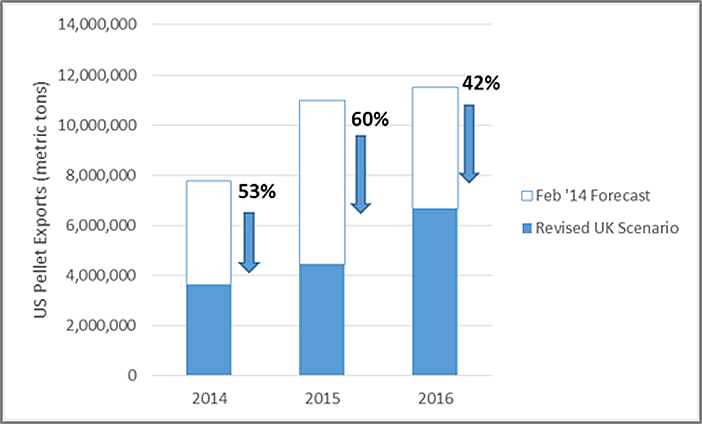For timberland investors and managers, the past twelve months have produced a series of positive events and encouraging data points. Across forest industry markets – from lumber to plywood to oriented strand board (OSB) to pulp – demand for wood raw materials has increased in all major U.S. regions. However, the story for timber markets involved with wood bioenergy projects remains murky. Why? First, as documented in the May issue of Wood Bioenergy US, project failures outpace project successes in the US. In the past three years, 66 new wood biomass plants became operational, while 134 were shut down or cancelled. Second, support for wood bioenergy in the UK has softened, further affecting select renewable energy investments.
Amanda Lang, Managing Editor of Wood Bioenergy US, led a research project addressing the question, “How could weakening resolve for wood bioenergy in the UK affect US timberland owners?” This article summarizes key findings.
Reconciling Timber Forecasts with UK Wood Pellet Demand
Pine pulpwood stumpage price forecasts in the 2014 Forisk Forecast include projections of pine pulpwood use by wood bioenergy projects. The largest proportion of increased wood demand for energy is attributed to wood pellet projects planning to export to customers in the UK and EU. However, recent UK government decisions regarding investment contracts create uncertainty for biomass projects as well as pellet producers in the US that export to firms in the UK.
Recently, the UK government set boundaries on investments in renewable energy. For example, on April 23, 2014, the UK decided to award only one of Drax’s two planned unit conversions an “early investment” contract. Previously, in December 2013, the government excluded a large conversion project at Eggborough from early funding as it was declared not “provisionally affordable.” The UK has established limits with respect to funding allocations as well as the types of renewable investments that it will support.
Implications for Timberland Investors
Forisk’s UK demand projections imply that pellet production capacity in the US will develop slower than expected, and will reach lower levels than expected given announcements by pellet developers. US pellet exports are projected to be 53% lower in 2014 than the pellet manufacturing capacity projected in the Forisk Forecast, given recent UK announcements (Figure). This translates into 26% less pine pulpwood use for bioenergy in the US South in 2016 relative to the projection in the Forisk Forecast.

Source: Wood Bioenergy US, Forisk Consulting, May 2014
Despite this decrease in expected pine pulpwood demand for bioenergy, the average stumpage price expectation for the South decreases by only 2% for 2016: from $12.32 per ton in the original Forisk Forecast to $12.07. The modest impacts reflect the facts that (1) bioenergy demand for pine pulpwood accounts for only 7% of total pine pulpwood demand in 2016 and (2) major price effects occur locally depending on the specific locations of failed pellet projects.
This content may not be used or reproduced in any manner whatsoever, in part or in whole, without written permission of LANDTHINK. Use of this content without permission is a violation of federal copyright law. The articles, posts, comments, opinions and information provided by LANDTHINK are for informational and research purposes only and DOES NOT substitute or coincide with the advice of an attorney, accountant, real estate broker or any other licensed real estate professional. LANDTHINK strongly advises visitors and readers to seek their own professional guidance and advice related to buying, investing in or selling real estate.










Add Comment